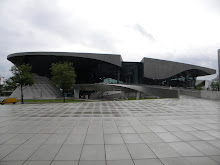
The one that I found the most interesting was the Berlin Wall. The Wall was in existence between August of 1961 and November of 1989 separating West Berlin from East Berlin. Although a major part of Berlin's history, the people wanted no remembrance of it, and so they began tearing it down piece by piece. Soon the Wall became a commodity as people were selling off pieces to make money, but eventually the demand would run out. Berlin struggled with the decision whether or not to tear the rest of the Wall down fully for years. I believe that they did a pretty good job of memorializing it by keeping a few sections of the Wall intact, opening the Checkpoint Charlie museum, and of coarse the Berlin Wall Memorial which consists of an outdoor exhibition in the former border strip, a documentation center, and Chapel of Reconciliation where daily prayer services for the victims of the Wall are held. Even though "the overwhelming desire was to be rid of the hated obstruction", I feel they made the right decision in memorializing it to show people that "in Berlin, Germany's wounds still lie open everywhere."
 The second memorial that I found interesting was the Soviet War Memorial at Treptow Park. This memorial symbolizes five thousand of the eighty thousand soldiers of the Red Army who fell in the Battle of Berlin in 1945. The Soviets defeated the Nazi regime and occupied East Berlin for many years under the name the German Democratic Republic (GDR). All of the GDR's monuments "were in the minds of Berliners not just a political statement but also a neighborhood icon, a repository of memories, or a vital piece of urban architecture." Postwar West Germany had "buried and denied its Nazi past", a mistake that would be repeated if all of the GDR's monuments were wiped away. So I felt that it was wise for them to keep the Soviet War Memorial.
The second memorial that I found interesting was the Soviet War Memorial at Treptow Park. This memorial symbolizes five thousand of the eighty thousand soldiers of the Red Army who fell in the Battle of Berlin in 1945. The Soviets defeated the Nazi regime and occupied East Berlin for many years under the name the German Democratic Republic (GDR). All of the GDR's monuments "were in the minds of Berliners not just a political statement but also a neighborhood icon, a repository of memories, or a vital piece of urban architecture." Postwar West Germany had "buried and denied its Nazi past", a mistake that would be repeated if all of the GDR's monuments were wiped away. So I felt that it was wise for them to keep the Soviet War Memorial.  Here, visitors pass through an expansive landscape of granite memorial sculptures until they reach a 38 foot tall statue of a soldier holding a sword in one hand, a child in the other, and stepping on a swastika, "a grand expression of heroism and triumph." It is regarded as the best and main Soviet memorial in existence in Germany.
Here, visitors pass through an expansive landscape of granite memorial sculptures until they reach a 38 foot tall statue of a soldier holding a sword in one hand, a child in the other, and stepping on a swastika, "a grand expression of heroism and triumph." It is regarded as the best and main Soviet memorial in existence in Germany.Throughout the book, we learn that Germany struggles with the decisions whether to keep and build these memorials of their hated past. Most citizens would much rather tear them all down and sweep everything under the rug. I was glad to see they decided to keep these memorials because, good or bad, it is part of their past and identity.

No comments:
Post a Comment